#Kronenhof
Explore tagged Tumblr posts
Text
Namibia 2023 / 24 - Tag 17
Herrschaften und Oukies!!!
Endlich einmal keinen Stress am frühen Morgen. Wir waren komplett perplex, dass wir heute die Ruhe weg haben konnten.

Natürlich dauert es bei dem geteilten Badezimmer in einem Familienzimmer etwas länger bis sich alle fertig gemacht haben.
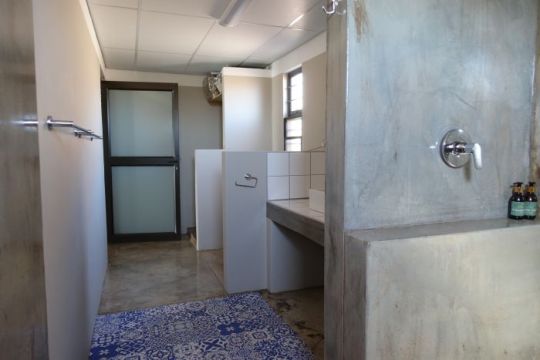
Dennoch waren wir um 8.30 Uhr startklar und so konnten wir heute in aller Ruhe das Frühstück genießen.
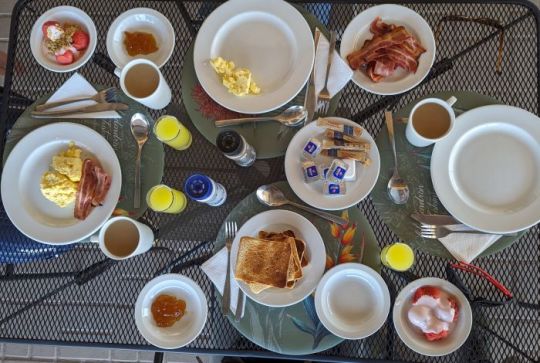
Es gibt ein Frühstückbuffet mit allem, was das hungrige Touristenherz begehrt. Und die Aussicht dazu ist einfach nur umwerfend.

Wir fühlen uns wie im Himmel und die Gastgeber sind wirklich der Hammer. So eine Fürsorge und Herzlichkeit, die die burische Familie ihren Gästen entgegenbringt ist, findet sich heutzutage nur noch sehr selten.

Die Lodge wurde erst im Jahre 2021 teil-eröffnet. Der ursprüngliche Baubeginn war bereits 2019, aber, wie überall auf der Welt, machte ihnen Corona einen Strich durch die Rechnung.
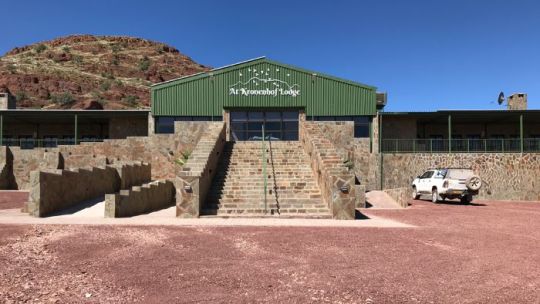
Wir erkunden die Lodge bzw. das wirklich sehr, sehr große Hauptgebäude. was auf den ersten Blick leicht überdimensioniert daher kommt, entpuppt sich auf den zweiten Blick als super gut durchdacht.
Von der großen Eingangshalle wird man erst einmal erschlagen, bis man feststellt, dass hier links und rechts vor der Rezeption Waschbecken installiert wurden, damit sich der Reisende erst einmal frisch machen kann.

Dazu gibt es einen Wasserspender, an dem man kostenlos, sofort nach Anreise, seinen gröbsten Durst löschen kann.
Zentral stehen zwei große Ruhebänke aus Leder und an der Wand befinden sich zu beiden Seiten der Eingangstür jeweils 12 Ladestationen für Handys & Laptops.

Die Rezeption ist das zentrale Herzstück des Hauptgebäudes. Angeschlossen ist ein Farmshop in dem man alles notwendige bekommt: von der Zahnpasta bis zum Souvenir über gefrorenes Fleisch oder gekühltes Bier.
Rechts neben der Rezeption geht es in das Restaurant, wobei bei schönem Wetter natürlich draußen auf der Terrasse serviert wird.

Links neben der Rezeption geht es in einen sehr gemütlichen Loungebereich, in denen man kühlere Abende, gegebenenfalls auch am Kamin, verbringen kann.
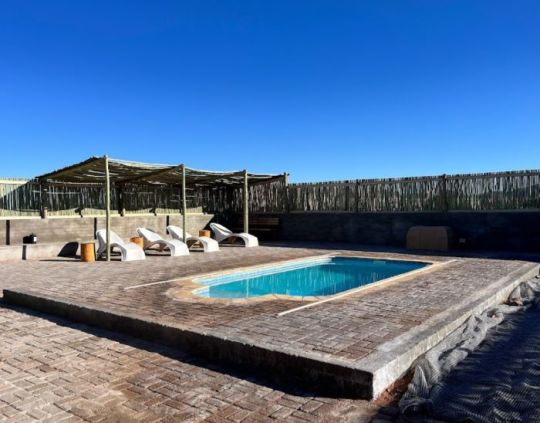
Dahinter schließt sich der Bereich für Pool und Entspannung an. Extrem lobenswert ist hervorzuheben, dass man weitestgehend versucht hat alles möglichst integrativ zu gestalten.
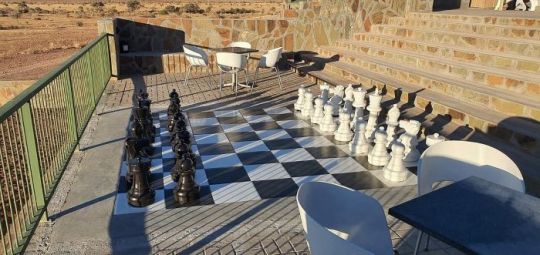
Überall sind Rampen vorhanden, ob an dem imposanten Hauptgebäude oder an den Chalets. Zudem sind die Toiletten, Waschräume und Badezimmer ebenfalls ausreichend großzügig konzipiert.
Für den späten Nachmittag buchten wir, zusammen mit einem südafrikanischen Paar aus Springbok, den Sundowner Drive.

Treffen für uns Teilnehmer war um 4.30 Uhr an der Rezeption. Dort fielen uns bereits zwei junge Paare auf, die gerade als Camper eincheckten. Doch dazu später mehr.
Selbstverständlich waren wir Gamedrive-tauglich angezogen mit großen Hut, Sonnenbrille und auch einer Jacke für die kühleren Stunden am Abend.
Der Eigentümer (dessen Namen ich sträflicher Weise vergessen habe) fuhr uns persönlich über das Gelände der Lodge. Wir erfahren, dass insgesamt rund 15.000 Hektar zur Farm gehören.

Dieses Gelände wurde dann etwa zu 50:50 aufgeteilt, in Game Lodge und Viehwirtschaft. Karakulschafe bringen halt nicht mehr viel ein und der Export von Rindfleisch nach Südafrika brach drastisch ein.
Durch das elendige Loadshedding und die ständigen Stromausfälle kann man die Kühlketten für Lebensmittel dort kaum noch gewährleisten.
So hat man nun Wildtiere angesiedelt bzw. eingekauft und dann angesiedelt. Dem geübten Afrika Reisenden fällt dabei natürlich auf, dass die Weißschwanzgnus oder Bonteboks hier gar nicht hingehören, aber das schmälert das Erlebnis kein bisschen.
Wir erfahren auch einige geschichtliche Details, beispielsweise, dass über das Farmgelände ursprünglich die Verbindungsstrecke von Lüderitz zum Schloss Duwisib führte.

Der größte Berg auf dem Gelände diente den deutschen Schutztruppen dabei als "Signal Hill" und oben war ein Heliograph installiert, der mittels Morsezeichen Nachrichten weiter gab.
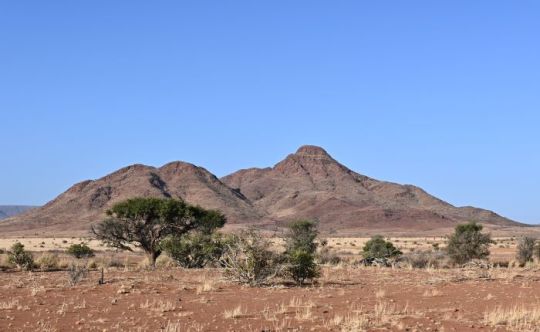
In einiger Entfernung sehen wir eine Gruppe Bergzebras, die uns gegenüber allerdings sehr misstrauisch sind und die Fluchtdistanz entsprechend groß halten.
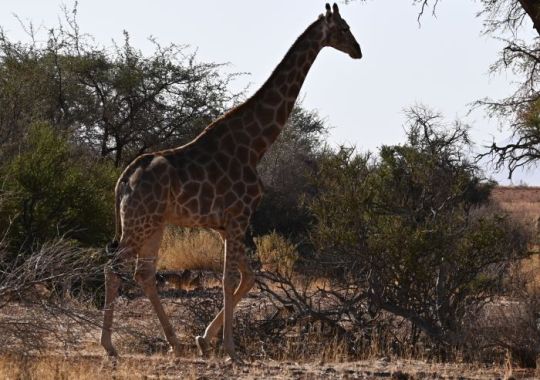
Deutlich entspannter sind dagegen die Giraffen, die sich zwischen den Akazien in der Nähe eines Trockenreviers aufhalten.

Leider zu weit weg, um ein vernünftiges Foto zu schießen, bewegt sich die Herde der Bonteboks.
Dafür erkennen wir die Bergzebras recht gut. Sie laufen immer ein Stück und bleiben dann stehen, um uns zu beobachten.

Wir scheuchen ein Pärchen Löffelhunde auf, die umgehend das Weite suchen.
Wir sehen in den Bäumen riesige Webervogelnester.

Auf dem Weg liegen sehr viele Tsamma Melonen. Die Tsamma ist eine wilde Verwandte der kultivierten Wassermelone. Sie ist absolut ungiftig, aber für uns ungenießbar bitter. Die indigenen Stämme der Nama und San sind es allerdings gewohnt die Tsamas zu essen und so Flüssigkeit zu sich zu nehmen.
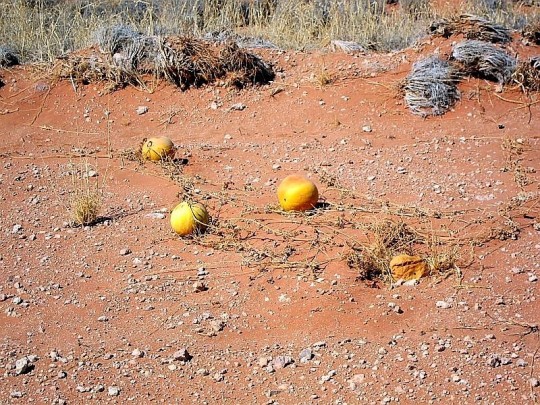
In Vorbereitung des Feldzugs der Schutztruppe gegen die Nama (1908) wurden die Schutztruppensoldaten und deren Kamele darauf trainiert Tsama Melonen zu essen. Um diese für die Soldaten geschmacklich etwas attraktiver zu machen wurde Brausepulver Orange von Dr. Oetker darübergestreut.

Die Sonne verschwand schnell hinter den Bergen und die Dämmerung kam schnell auf dieser Seite des Berges.

Aber, einmal um die Ecke herum und noch ein paar mehr Kurven, dann ging es schon schaukelnd den Berg hinauf.

Die Strecke war rau, aber es ging zügig voran. Oben angekommen empfängt uns ein gemauerter Sundowner Platz.

Während wir so an unserem Gin-Tonic herum nuckeln und der Sonne beim Verschwinden hinter dem Berg zuschauen, entdecken wir plötzlich mehre Lichter von Fahrzeugen, die sich auf dem Farmgelände bewegen.

Wir scherzen zuerst: "Ach, guck, da kommen noch Gäste". Aber, nein, weit gefehlt! Die Gruppe junger Leute von vorhin, die sich auf der Gemeinschaftscampsite einmieteten, nahmen offensichtlich an, sich auf dem Gelände nach eigenem Gutdünkel bewegen zu können und fuhren munter in der Dämmerung umher.

Wer nun glaubt, das sei der Gipfel der Unverfrorenheit, der wird später noch eines Besseren belehrt.
Nachdem die Sonne ganz hinter den Bergen verschwunden war und die "Blaue Stunde" anbrach, fuhren wir zurück zur Lodge, wo ein opulentes Mal auf uns wartete.
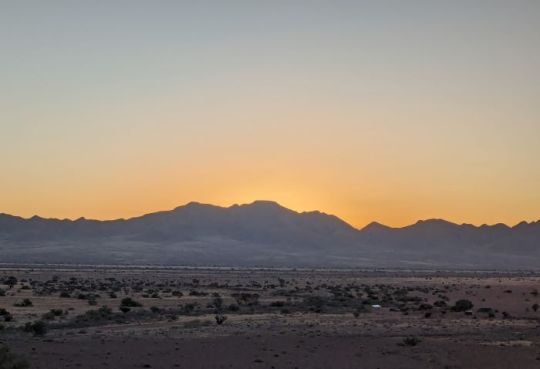
In Namibia dreht sich alles ums Fleisch: Wild und Rind stehen an erster Stelle und übertreffen wahrscheinlich jedes Biosiegel Europas um ein vielfaches.
Das zarte Antilopenfleisch von Springbock, Oryx, Kudu oder Eland sind ein absoluter Genuss, immer perfekt gebraten oder gegrillt, und mit ideal abgestimmten Gewürzen hält man sich hier nicht zurück.

Gestern Abend gab es ein phantastisches Steak von der Oryxantilope.

Heute gab es Lammkeule in Sauce. Selbst Micha, der bekanntlich kein großer Fan von Lammfleisch ist, haute rein, wie der Max in die berühmten Cremeschnitten.
Im wahrsten Sinne des Wortes "Papp"satt (kommt tatsächlich vom hiesigen Nationalgericht Papp) schleppten wir uns zu unserem Bungalow.
Meine Mutter machte sich bettfertig, wir packten unseren Kram schon einmal weitest gehend zusammen und setzten uns noch ein wenig auf unsere Terrasse um den Vollmond zu bewundern.
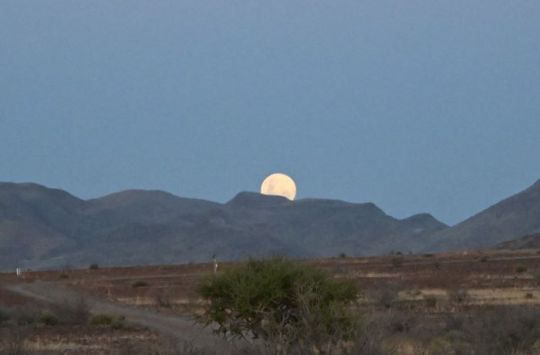
Gegen 23 Uhr fuhr plötzlich ein Fahrzeug vor das Hauptgebäude vor. Wir glaubten an späte Gäste und machten schnell das Licht aus, da die Eigentümer schon auf ihrer Farm weilten, und wir nicht in die Verlegenheit kommen wollten, irgendwie noch angesprochen zu werden.
Am nächsten Morgen stellte sich aber heraus, dass den jungen Herrschaften wohl das Bier auf der Campsite ausgegangen war und sie noch gerne etwas Nachschub besorgen wollten ...
Wir verstehen jeden Gästebetrieb, der den Campingbetrieb einstellt, weil er auf solche Flitzpiepen einfach keine Lust mehr hat.
Lekker Slaap!
Angie, Micha, Mama und der Hasenbär
11 notes
·
View notes
Text

Le Grand Hotel Kronenhof a fêté ses 175 ans en septembre dernier. L’occasion pour Beax de donner des couleurs à ce magnifique établissement 5 étoiles, situé à Pontresina en Suisse.
The Grand Hotel Kronenhof celebrated its 175th anniversary last September. The opportunity for Beax to add colors to this magnificent 5-star establishment, located in Pontresina in Switzerland.
0 notes
Text
Luxury Swiss Getaways for Photography Apparel
Discover the Beauty of Switzerland through your Camera The Swiss Alps Switzerland is famous for its stunning mountain ranges, especially the Swiss Alps. The Alps provide the perfect backdrop for photographers who want to capture the beauty of nature. During winters, the Alps are covered in snow, creating a magical winter wonderland. In the summer, the mountains are lush green, and you can capture the beauty of the sun-kissed peaks. Switzerland's famous Matterhorn mountain is a great spot for photographers. Shooting at sunrise or sunset can capture the beauty of the Matterhorn in its full glory. Lake Geneva Lake Geneva is another stunning location in Switzerland that is perfect for photography. The blue-green waters of the lake surrounded by the beautiful Swiss Riviera and the snow-capped Alps make it a perfect location for photography. You can capture the beauty of the Swiss vineyards, villages, and castles around the lake. A boat ride around the lake provides a unique perspective on the landscape and is a must-try. Swiss Villages Switzerland is dotted with small charming villages that look straight out of a fairy tale. These villages provide ample opportunities for photographers to capture the rustic beauty of Swiss architecture and culture. Some famous Swiss villages that you should check out are Wengen, Gstaad, Interlaken, and Bern. These villages have cobblestone streets, beautiful houses, and breathtaking views that make them perfect for photography. Swiss Lakes Switzerland has a plethora of magnificent lakes that provide an excellent location for photography. Lake Lucerne is one of the most picturesque lakes in Switzerland, surrounded by snow-capped mountains. The Lake is known for its stunning reflections, which make for the perfect photo opportunity. Lake Thun is another lake that is perfect for photography. The Lake is surrounded by beautiful mountain parks, gardens, and forests that make for a stunning landscape. Switzerland is a paradise for photographers with its stunning landscapes, mountains, lakes, and villages. If you're a photographer, you can't miss the chance to capture Switzerland's natural beauty. Whether you're into landscapes, architecture, or nature photography, Switzerland has something for every photographer. So pack your camera and head to Switzerland for the photography adventure of a lifetime. When it comes to capturing stunning photographs, the location of your accommodation can make all the difference. Here are some of the top luxury accommodations in Switzerland that provide an ideal base for photographers to explore and capture the picturesque landscapes. 1. The Alpina Gstaad The Alpina Gstaad is located in the heart of the Bernese Alps and offers stunning views of the surrounding mountains. The hotel features contemporary Alpine-style rooms, a spa, and an outdoor pool. The location provides photographers with a great opportunity to capture the Swiss Alps in all their glory. 2. The Beau-Rivage Palace The Beau-Rivage Palace is situated on the banks of Lake Geneva and is surrounded by lush greenery and the stunning Swiss Alps. The luxury hotel features elegant rooms, a spa, and a collection of restaurants. Photographers can capture the stunning sunrise and sunsets over the lake. 3. The Grand Hotel Kronenhof The Grand Hotel Kronenhof is located in the heart of the Swiss Alps and offers amazing views of the surrounding mountains. The hotel features luxurious rooms, a spa, and an indoor pool. Photographers can capture the stunning landscape from the hotel's panoramic terrace. 4. The Mandarin Oriental Geneva The Mandarin Oriental Geneva is located on the banks of the Rhône River and offers stunning views of the Jet d'Eau fountain. The luxury hotel features contemporary rooms, a spa, and a rooftop terrace. Photographers can capture the stunning views of the fountain and the cityscape. 5. The Park Gstaad The Park Gstaad is situated in the Saanenland region of the Swiss Alps and offers stunning views of the surrounding mountains. The hotel features luxurious rooms, a spa, and an outdoor pool. Photographers can capture the stunning mountain landscapes and breathtaking sunsets from the hotel's terrace. These are just some of the top luxury accommodations in Switzerland that offer photographers a fantastic base to explore and capture the country's stunning landscapes. Choose one of these hotels for your next photography apparel getaway and enjoy an unforgettable experience. Best Swiss Cities for Photography Apparel Shopping 1. Zurich Zurich is a great city for shopping for photography apparel. The city is known for its fashion, with many designer boutiques and luxury stores lining its streets. Bahnhofstrasse is the main shopping street in Zurich, where you can find stores like Globus and Jelmoli. Globus is a high-end department store that sells luxury clothing, watches, and accessories. Jelmoli is another department store that has a great selection of camera bags, lens filters, and tripods. 2. Geneva Geneva is another great city for shopping for photography apparel. The city is home to many luxury brands, including Rolex, Patek Phillipe, and Chopard. Rue du Rhône is Geneva's most famous shopping street and is home to many luxury stores. Some of the best stores for photography apparel in Geneva include FotoVideo, which has a great selection of camera bags, tripods, and accessories, and Luxury Replica, which sells high-quality replica watches. 3. Lausanne Lausanne is a smaller city compared to Zurich and Geneva, but it still has many great stores for photography apparel. Rue de Bourg is the main shopping street in Lausanne and has many high-end boutiques. Some of the best stores for photography apparel in Lausanne include Focale, which has a great selection of camera bags and accessories, and Photo Vision, which sells a variety of camera equipment and lenses. 4. Bern Bern may not be as well-known for its shopping as some of Switzerland's other cities, but it still has many great stores for photography apparel. The city's old town is home to many small boutiques and shops selling unique items. Some of the best stores for photography apparel in Bern include Foto Zumstein, which has a great selection of camera equipment, and Leica Store Bern, which sells Leica cameras and accessories. Overall, Switzerland has many great cities for photography apparel shopping, each with its own unique selection of stores. Whether you're looking for high-end luxury stores or smaller boutiques selling unique items, you're sure to find what you're looking for in one of Switzerland's cities. Capturing the Magic of Swiss Mountains Switzerland is known for its iconic landscapes and stunning mountain ranges, making it a haven for photographers and nature enthusiasts alike. The Swiss Alps, one of the most popular mountain ranges, offer breathtaking views of snow-capped peaks, crystal-clear lakes, and rolling meadows of wildflowers. The Best Time to Visit The best time to capture the magic of Swiss mountains is during the summer months, from June to September, when the landscapes are lush green and the weather is pleasant. However, if you're interested in capturing snowy landscapes, November to March is the ideal time to visit. Where to Go The Swiss Alps have several photogenic spots that are worth visiting. Some of the must-visit places include Jungfraujoch, Mount Titlis, Matterhorn, and Aletsch Glacier. The Viamala Gorge, a spectacular gorge, is also a hidden gem and an excellent spot for adventurous photographers. Photography Tips When it comes to capturing the magic of Swiss mountains, here are some essential photography tips: - Use a polarizing filter to reduce glare and enhance the colors of the landscape. - Shoot during the golden hour, which is the hour after sunrise and the hour before sunset, to capture stunning light and shadows. - Experiment with different angles and perspectives to create unique compositions. - Include a human element, such as a hiker or a skier, to add scale and depth to your photographs. - Use a tripod to stabilize your camera and for long exposure shots. Capturing the magic of Swiss mountains is a once-in-a-lifetime experience and a dream come true for any photographer. With its breathtaking landscapes and stunning vistas, Switzerland has something for everyone. Remember to pack your camera gear, come prepared, and capture the beauty of this stunning country. Photographing the Swiss Countryside The Swiss countryside is a photographer's paradise, with stunning landscapes that offer a perfect blend of natural beauty and man-made architecture. Whether you're a professional or amateur photographer, capturing the beauty of the Swiss countryside is a must-do activity on your next visit to Switzerland. Best Time to Photograph the Swiss Countryside The best time to photograph the Swiss countryside is during the summer months when the landscape is in full bloom. From June to August, you'll find colorful fields of wildflowers, lush green valleys, and clear blue skies that offer the perfect backdrop for your photographs. Winter also offers a unique perspective, with snow-clad mountains and picturesque towns. Best Places to Photograph the Swiss Countryside Switzerland is full of scenic locations that are perfect for photography. From the famous Alps to the picturesque villages, there are countless places to capture stunning images. Here are a few of our favorite places: - Lucerne: A charming city situated on the shores of Lake Lucerne, providing a perfect backdrop for photographs - Lauterbrunnen Valley: Known for its steep cliffs, waterfalls, and alpine meadows - Zermatt: The iconic Matterhorn mountain and the picturesque town are perfect photography subjects - The Rhine Falls: One of the largest waterfalls in Europe - Gruyeres: A beautiful medieval town with a castle, cobbled streets, and stunning views of the valley Here are a few tips to help you capture stunning photographs of the Swiss countryside: - Use a polarizing filter to emphasize the blue skies and green landscapes. - Experiment with different angles and perspectives. For example, using a low angle can make the mountains look more imposing. - Take advantage of the "golden hour," which is the hour before sunrise and after sunset, to capture beautiful warm tones. - Use a tripod to ensure your photos are sharp and clear, particularly when capturing waterfalls or other moving subjects. - Don't forget to photograph the small details, which can add interest to your photos. Whether you're an amateur or professional photographer, the Swiss countryside offers endless opportunities for capturing stunning images. With its breathtaking landscapes, charming villages, and fascinating architecture, Switzerland is one of the most photogenic places in the world. Exploring Swiss Lakes and Waterfalls Switzerland is known for its breathtaking lakes and waterfalls that are sure to leave you captivated. Here are some of the most stunning ones you must add to your itinerary during your luxury Swiss getaway. Located on the border of Switzerland and France, Lake Geneva is one of the largest lakes in Europe, and a must-visit destination. It’s surrounded by the stunning Swiss Alps, offering picturesque views. You can go for a boat ride, take a dip in the clear waters or enjoy a stroll along the lakeside promenade. Don't forget to take photos of the Jet d'Eau, the famous 140 meter-high water fountain in the middle of the lake. Lake Lucerne This picturesque lake is located in the heart of Switzerland and surrounded by mountains that provide a stunning backdrop. You can take a boat ride, hire a paddleboat and explore the lake at your leisure, or go for a swim in the crystal-clear water. A visit to the Chapel Bridge, the oldest wooden bridge in Europe, is not to be missed. Trümmelbach Falls Trümmelbach Falls, situated in the Lauterbrunnen Valley, is one of the most impressive waterfalls in Europe. The waterfall is fed by the melting glaciers of the Jungfrau Mountains, making it a truly unique attraction. You can take a guided tour that takes you through the ten underground waterfalls. Rhine Falls Rhine Falls is the largest waterfall in Europe and is located in northern Switzerland. The waterfall is a truly mesmerizing sight, with its thundering water cascading down the rocks. You can take a boat ride that will take you right up close to the falls or enjoy a picnic on the banks of the river. Lake Thun Lake Thun is a stunning lake located in the Bernese Oberland region of Switzerland. The lake is surrounded by the Swiss Alps, providing beautiful views from every angle. You can take a boat ride, go for a swim or enjoy the local cuisine at one of the restaurants that line the lake. The Swiss lakes and waterfalls provide some of the most unforgettable experiences and are must-sees during your Swiss getaway. The stunning backdrop of the Swiss Alps, picturesque scenery and waterfalls make for an unforgettable experience for any photographer. Swiss Photography Workshops and Tours Switzerland is a photographer's paradise, with its stunning landscapes, picturesque villages, and charming cities. For photography enthusiasts, there's no better place to hone your skills, learn new techniques, and capture incredible images. Swiss photography workshops and tours offer a unique opportunity to explore the country's most beautiful locations while improving your photography skills. Workshops Switzerland is home to some of the world's best photography workshops, catering to beginners and professionals alike. These workshops are led by experienced photographers who provide personalized instruction, tips, and feedback to help you improve your technique and creativity. From landscape and nature photography to portrait and street photography, there's a workshop for every interest. Tours Switzerland is also home to a variety of photography tours that take you to the country's most beautiful locations and provide unique opportunities to capture stunning images. These tours are led by local photographers who know the area well and can guide you to the best spots for photography. Whether you're interested in capturing the Swiss Alps, picturesque villages, or architectural wonders, there's a tour for every interest. Some popular photography tours in Switzerland include the Swiss Alps Photography Tour, which takes you to the most scenic mountain locations in the country, the Swiss Village Photography Tour, which explores the charming villages of Switzerland, and the Zurich City Photography Tour, which focuses on capturing the city's architecture and urban scenes. Switzerland is truly a photographer's dream destination, with its stunning landscapes, charming cities, and picturesque villages. Photography workshops and tours in Switzerland offer a unique opportunity to explore and capture the beauty of this incredible country, while improving your photography skills. With so many options to choose from, there's a workshop or tour for every interest and skill level. Book your Swiss photography adventure today and take home memories that will last a lifetime! If you're looking for the ultimate luxury photography getaway, look no further than Island Hopping in Greece - a stunning adventure that promises to inspire and delight. Read the full article
1 note
·
View note
Text
Eh, not much to comment on for the Vermeer caper. Neither Team Red’s hotel nor the drive to Cleo’s château have any clear real-world counterparts

(though if I had to guess, I’d say the Grand Hotel Kronenhof was the most likely inspiration here) aside from the hilliness of the landscape suggesting somewhere in the Swiss-to-Austrian Alps. German is the majority language in both Switzerland and Austria, so Countess Cleo’s use of “wunderbar” would be appropriate to either. However, drawbridges aren’t really a thing in the Alps—probably because they just don’t have the type/volume of water travel to need them—so that might actually be a nod back to the Netherlands, where they are much more common.
(update: As of the San Fran caper, Julia notes that Chase drove into a Swiss lake, confirming Cleo’s chateau to be in the Swiss rather than Austrian Alps.)
One thing I do want to point out:

This is NOT where the Rijksmuseum is located. That would be here (bottom arrow)

several canals AWAY from where the show has the Rijksmuseum (top arrow) and from Carmen’s exit route (following the Singel canal to where it joins the Amstel River)

and I’m not sure why that particular detail was fudged

except to be able to use the Muntttoren (the clock tower she passes) as a Significant Background Landmark for Amsterdam.
More trivia! (this time with Extra Maps™)
For interest’s sake I was trying to figure out where in Poitiers Cleo’s hôtel particulier might be, plus identify the train stations featured during Carmen’s trip to Paris—and I think I’ve figured (most of) it out.
First of all, Carmen is supposed to be fifty yards from the townhouse in this shot.

Keep reading
#plus it's not even a particularly accurate - and that's AFTER making allowances for the show's art style - rendering of the munttoren#so why they felt it was so important to include#i really can't say#though i do enjoy how hard the duchess's unmasking leans into the Rule of Dramatique XD#where was carmen /keeping/ all that hair? and why does the wig act like it's glued to her hat? We Don't Know but it sure looks cool XDD#carmen sandiego 2019#carmen sandiego#countess cleo#nixariel
35 notes
·
View notes
Link
Wherever you're staying in Switzerland with your family or on an adventure, I've got you covered.Without really trying, these hotels perfectly capture the splendor of Switzerland's various picturesque surroundings.
For more informations click the link below or visit our YouTube Channel
https://www.youtube.com/watch?v=HM0HXxWTKwE
#Burgenstock Hotel & Alpine Spa#Hotel Villa Honegg#Hotel d'Angleterre Geneve#The Omnia Zermatt#Hotel Chateau Gutsch Lucerne#Grand Hotel Kronenhof Pontresina#Hotel The Cambrian Adelboden#Ascher Guesthouse#Bellevue Palace Bern#Baur Au Lac Zurich
1 note
·
View note
Text


Grand Hotel Kronenhof
4 notes
·
View notes
Photo




Golf in the Wide, Open Spaces of Switzerland’s Engadine Valley
With overseas golf trips back on the agenda, now is the ideal time to visit the wide open spaces and crystal clear air of Switzerland’s Engadine Valley to experience a spectacular Alpine round against a backdrop of majestic mountains and expansive blue skies.
There is no better place to stay than the iconic Kulm Hotel St. Moritz (www.kulm.com) or its sister property Grand Hotel Kronenhof (www.kronenhof.com) in nearby Pontresina, two luxurious grand dames with plenty of public areas and private grounds to relax in after a round at one of the region’s three courses.
Golf has long been associated with the Kulm Hotel, which established its own historic course in 1891, making it one of the first in Switzerland. The 9-hole, par 3 meanders up and down hills, past the Olympia Bob Run and the former Olympic Stadium, through shady pine copses whilst also enjoying superb vistas over Lake St. Moritz, all just a 7 iron from the Kulm Hotel. Built at a height of 1,860 metres (among the highest in Europe), the mountainous layout makes it physically demanding, which makes the post-golf drinks on the terrace of the Chesa al Parc club house taste all the sweeter!
Meanwhile the Engadine Golf Club, the oldest golf club in Switzerland, has two courses – Samedan and Zuoz-Madulain, which are a 10 and 20 minute drive respectively from the Kulm Hotel and Grand Hotel Kronenhof.
In 1893, Samedan was the first 18-hole golf course to open its doors in Switzerland. A classic, parkland course, Samedan is set mainly on the valley floor, though some gently undulating holes and greens give the course a links feel. Its broad fairways are flanked by ancient, giant larch trees, some of which are over 700 years old, whilst a host of water hazards make for a tricky golfing challenge.
Zuoz-Madulain (known simply as Zuoz to the locals) opened in 2003 and was designed by the renowned Canadian golf course architect Les Furber. In contrast to the golf course in Samedan, the layout at Zuoz offers a challenging combination of undulating fairways, elevation changes and receptive greens, plus a super attractive setting as it is flanked on one side by natural thick pine forest, which has made it very popular among the golfing community.
Away from the golf courses, visitors can explore the extensive Engadine valley via its hiking routes and mountain bike paths, whilst the numerous lakes provide plenty of opportunities for a range of water sports, such as wild swimming, stand-up paddle boarding and kite surfing. After an active day outdoors, both hotels have large luxurious spas and multiple bars and restaurants in which to enjoy some well-deserved R&R.
The Kulm Hotel’s ‘Golf Break’ package starts from CHF 620 pp sharing a double room, including:
2 nights’ accommodation on a half-board basis Complimentary green fees at the 9-hole Kulm Golf St. Moritz* 1 complimentary green fee on the 18-hole Samedan or Zuoz-Madulain golf courses* unlimited access to the Kulm Spa St. Moritz unlimited use of the hotel’s tennis courts unlimited use of all open mountain railways in the Engadine / St. Moritz region and public transportation in the valley (bus and Rhaetian railway) *Tee time bookings to be made upon reservation confirmation.
Reservations can be made by phone on +41 81 836 80 00 or by e-mail on [email protected].
Grand Hotel Kronenhof’s ‘Golf - All in One’ package starts from CH 515 pp sharing a double room, including:
2 nights’ accommodation on a half-board basis Complimentary green fees at the 9-hole Kulm Golf St. Moritz* 1 complimentary green fee on the 18-hole Samedan or Zuoz-Madulain golf courses* unlimited access to the Kronenhof Spa unlimited use of all open mountain railways in the Engadine / St. Moritz region and public transportation in the valley (bus and Rhaetian railway) *Tee time bookings to be made upon reservation confirmation.
Reservations can be made by phone on +41 81 830 30 30 or by e-mail on [email protected].
The Kulm Hotel St. Moritz will close on 6 September 2020, while Grand Hotel Kronenhof will stay open through the Autumn until 18 October 2020, allowing golfers to also enjoy some spectacular autumn vistas as the larch trees change from green to golden.
3 notes
·
View notes
Text
Namibia 2023/24 - Tag 18
Herrschaften und Oukies!
Nach dem Frühstück, bei dem wie heute die einzigen Gäste waren, verließen wir die At Kronenhof Lodge.
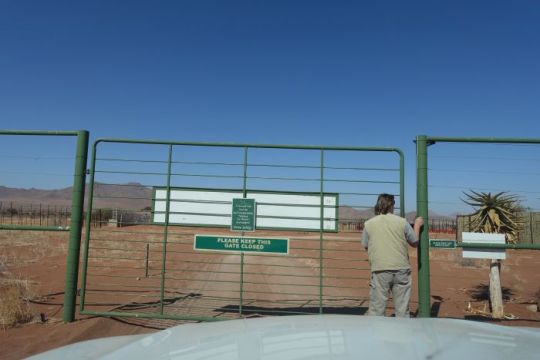
Nachdem gefühlt 20 Farmtore zu öffnen und wieder zu schließen waren, fuhren wir erst einmal das kurze Stückchen bis nach Betta.
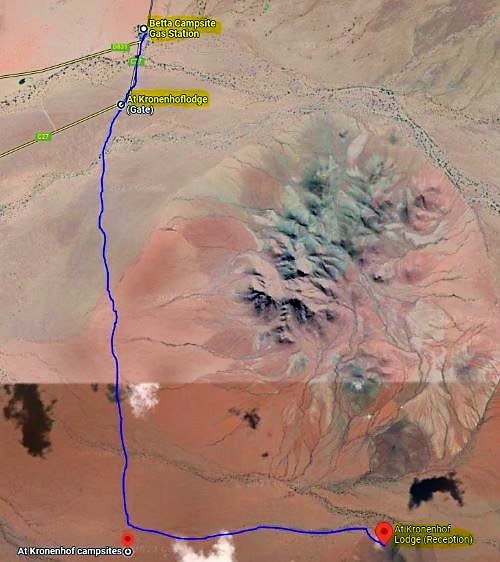
Das ist auch so ein verlorenes Wüstenkaff, in dem es aber alles gibt was man so braucht, einschließlich Unterkunft.

Das Betta Camp liegt 10 km nördlich von der Kronenhof Lodge entfernt. Eine Pause zum Auftanken im Camp Betta, an der C 27, ist auf dieser Strecke zu empfehlen.

Das Areal des kleinen, günstigen Campingplatzes ist liebevoll gestaltet und pieksauber. Zusätzlich gibt es 6 rustikale Chalets aus Naturstein.
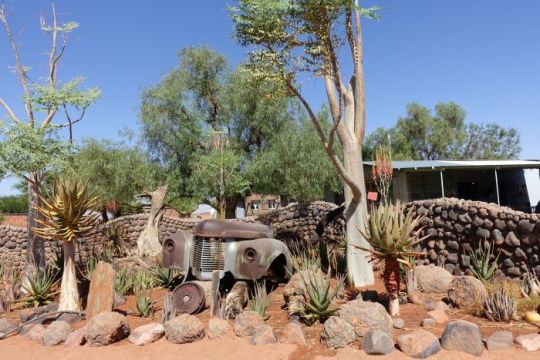
Gepflegt und unterhalten wird das Camp Betta von Nama-Frauen. Die bereiten auf Wunsch ausgezeichneten Kaffee zu und versorgen den Reisenden mit frisch zubereiteten Sandwiches und anderen Mahlzeiten.
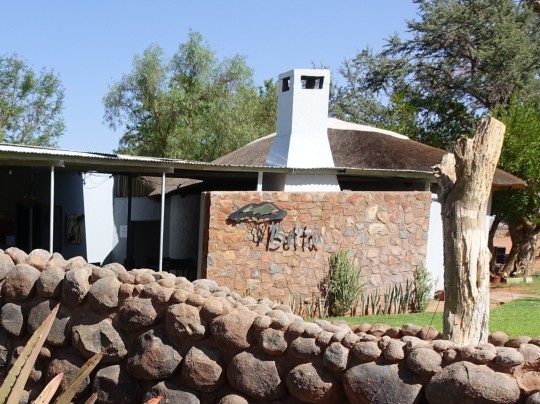
Die wichtigste Einrichtung ist jedoch die 24/7 Tankstelle mit angeschlossenem Tyre-Repair.
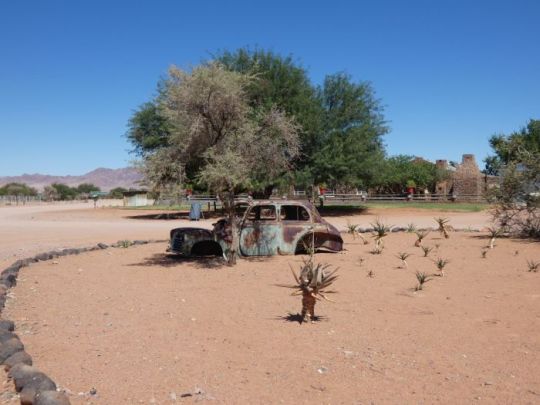
In dem kleinen, angeschlossenen Farmladen gibt es alles für den täglichen Bedarf an Lebensmitteln zu kaufen - vom selbstgebackenen Brot über selbstgemachte Marmeladen bis zum Straußenei.

Wir decken uns mit Marmelade und Sirup aus dem Saft der Kaktusfeige ein, denn diese Produkte gibt es bei uns nicht zu kaufen. Der junge Mann an der Kasse staunte nicht schlecht, als ich ihm die ganze Theke mit Säften und Marmelade vollstellte.
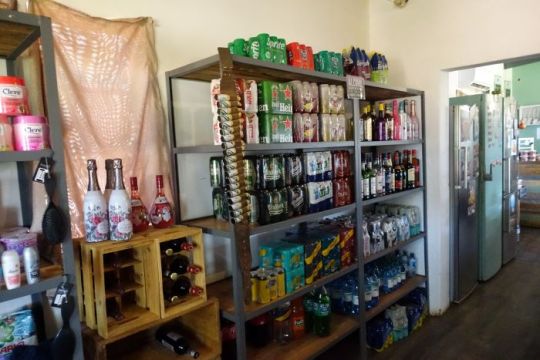
Darüber hinaus gibt es für den Reisenden noch etwas Bekleidung, Sonnencreme, Straßenkarten usw. usw. Die Auswahl an Artikeln in dem kleinen Laden ist erstaunlich vielfältig.
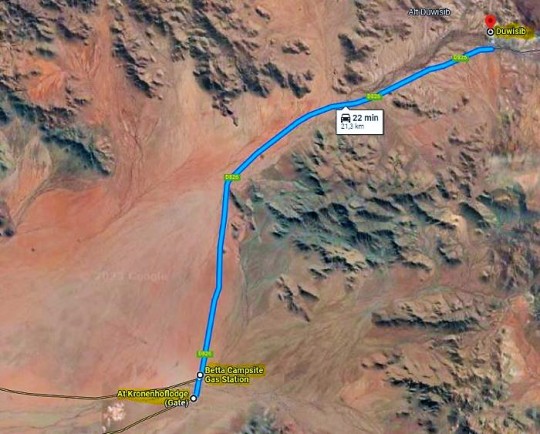
Wir folgen der D 826 auf den nächsten 21 km, östlich, bis zum Schloss Duwisib. Ein deutsches Schloss in Namibia? Eine Fata Morgana?
Am Rande der Wüste Namib steht tatsächlich ein Schloss im Stile romantischer Rheinburgen – mit Zinnen und Brunnen im Innenhof.

An diesem Ort wirkt das grundsolide Bauwerk doch etwas skurril. 1908 hat Baron Hans-Heinrich von Wolff, der mit der Schutztruppe nach Namibia gekommen war, dieses Anwesen bauen lassen.
Der Berliner Architekt Wilhelm Sander, dem u.a. Windhoek seine drei Burgen verdankt, wurde mit dem Entwurf des hochherrschaftlichen Hauses auf Duwisib beauftragt.

Und so wuchs aus massivem roten Sandstein fernab aller Wege ein kleines Prachtexemplar wilhelminischer Neo-Romantik mit Stilelementen der Gotik und Renaissance. Der Grundriss ist ein einfaches Rechteck.
Handwerker aus verschiedenen europäischen Ländern wurden angeheuert. Fast alles wurde importiert, selbst der rote Sandstein, und aus dem 600 km entfernten Lüderitz auf kaum vorhandenen, holprigen Pfaden herbeigeschafft.
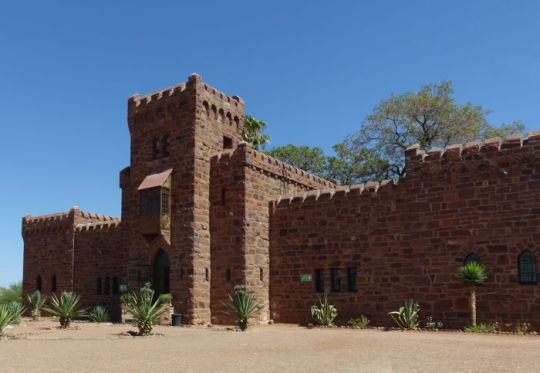
Die gesamte prunkvolle Inneneinrichtung für insgesamt 22 Zimmer, kostbare Möbel und Teppiche, Gemälde und andere Kunstgegenstände wurde in ganz Europa zusammen getragen. 1909 war Duwisib bereits bezugsfertig.
Besagter Hans-Heinrich von Wolf, 1873 in Dresden geboren, diente in der Königlich-Sächsischen Artillerie in Königsbruck. Nach Ausbruch des Herero-Aufstandes 1904 meldete er sich zur Kaiserlichen Schutztruppe und kam im Dezember des selben Jahres ins Land.
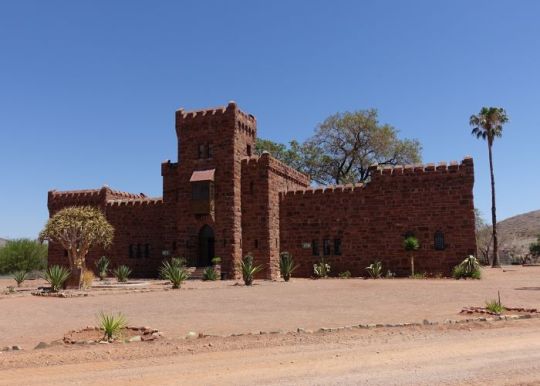
Gut ein Jahr später war von Wolf zurück in Deutschland und heiratete im April 1907 die millionenschwere Jayta Humphries, Stieftochter des in Dresden amtierenden amerikanischen Konsuls. Bald darauf reiste das junge Paar mit großen Plänen gemeinsam in die Kolonie.
In Deutsch-Südwestafrika wollte sich von Wolf als Großgrundbesitzer etablieren und Pferde züchten. Im August 1907 beantragte er beim Bezirksamt Maltahöhe den Kauf von sieben Farmen, insgesamt 140.000 Hektar Land. Der Antrag wurde allerdings nur teilweise genehmigt: von Wolf musste sich mit 55.000 Hektar begnügen.

Lange konnte er sich jedoch nicht an seinem Besitz erfreuen. 1914 trat das Ehepaar eine Reise nach Großbritannien an, um einen Vollbluthengst zu kaufen. Unterwegs brach der Weltkrieg aus, und über abenteuerliche Umwege mit Zwischenstation in Südamerika gelangte der kaiserliche Hauptmann in einen neutralen Hafen.
Zurück in Deutschland, meldete er sich sofort zum Dienst und fiel zwei Wochen später, im September 1916, in der Schlacht an der Somme. Seine Frau Jayta kehrte nie wieder nach Duwisib zurück.

Duwisib wurde nach der deutschen Kolonialzeit an eine schwedische Familie verkauft, die den Besitz ihrerseits an die Duwisib-Farmgesellschaft veräußerte.
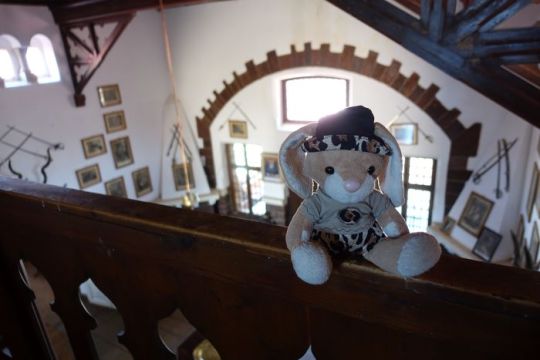
Bis Ende der 70er Jahre, als die damalige Abteilung Naturschutz (NWR) das Anwesen übernahm, wohnte dort der Farmverwalter. Die Inneneinrichtung war größtenteils eingelagert worden.
1991 wurde Duwisib renoviert und konnte als Museum besichtigt werden. Ein Teil der Möbel, Gemälde und von Wolfs Waffensammlung wurden ausgestellt.

In dem vom NWR verwalteten Gebäude fanden Gäste seit Ende 2014 für wenige Jahre Unterkunft. Leider, wie immer bei den staatlichen Einrichtungen, vergammelten die gemachten Investitionen wieder innerhalb kürzester Zeit (s. Bild vom Carport ohne Dach).
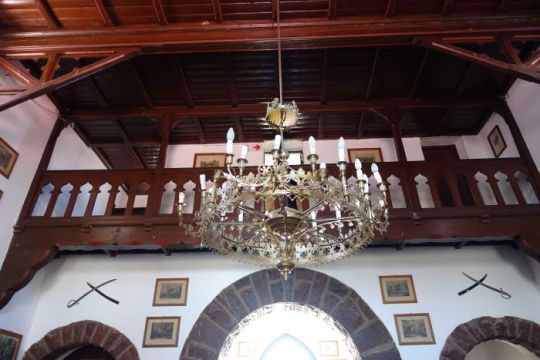
Seit geraumer Zeit ist Schloss Duwisib nun bereits für Besucher mehr geschlossen als geöffnet. Doch heute hatten wir wirklich Glück und der staatliche Gate Keeper war tatsächlich anwesend und wir konnten das Anwesen besichtigen.
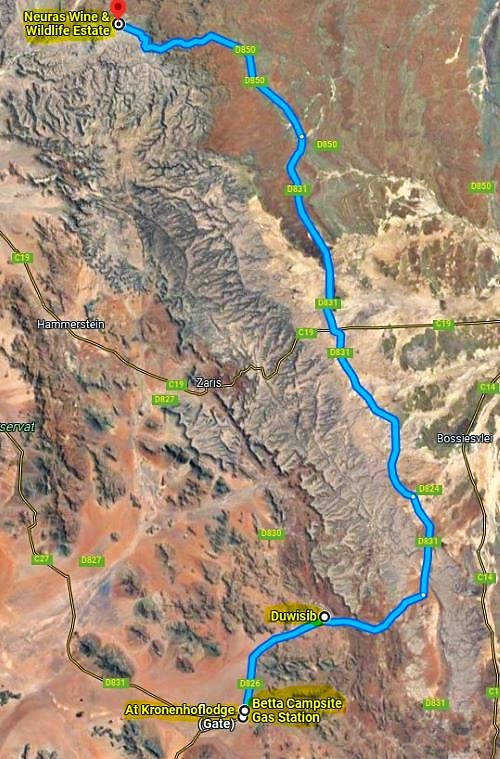
Anschließend fuhren bis zum Ende der D 826 und dort bogen wir auf die D 831 ab, welche später auf die D 850 mündet. Nach insgesamt 155 Kilometern erreichten wir das Weingut Neuras.
Wir waren neugierig auf das Weingut, denn hier waren wir bislang noch nie. Das von Naankuse betriebene Anwesen ist sehr gepflegt. Ein junger Angestellter hieß uns willkommen.
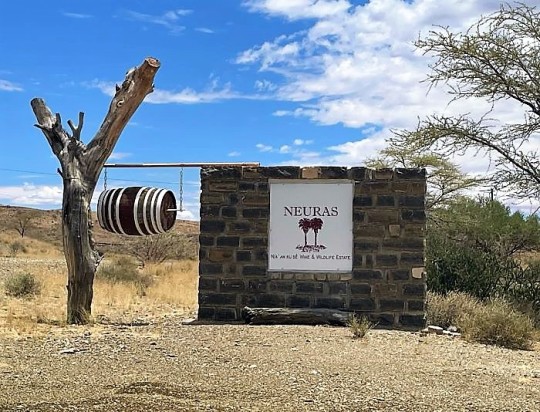
Wahre Widerstandskraft beweist die großartige Flora und Fauna, die auch hier bei dem Neuras Estate beobachtet werden kann. In der einheimischen Koikoi Sprache bedeutet Neuras "Ort des verlassenen Wassers".
Neuras ist ein kleines Weinbaugebiet und besitzt auf dem Gelände 5 natürliche Quellen. Es werden Führungen und Weinverkostungen mit Käseplatte angeboten.
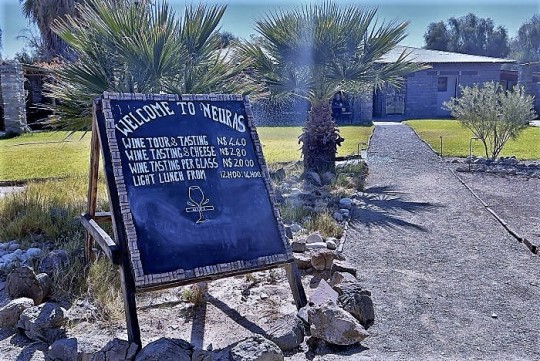
Hier werden die bekannten Neuras-Weine in einem der trockensten Weinberge der Welt produziert. In der einzigartigen, namibischen Weinkellerei werden ca. 3.000 Weinflaschen pro Jahr abgefüllt mit zwei Weinarten: den angesehenen Neuras Shiraz und den Namib Red, ein Rotwein aus Shiraz und Merlot. Die nur zirka 3000 pro Jahr abgefüllten Flaschen werden fast ausschliesslich im Weingut selbst verkauft.
Die Geschichte von Neuras beginnt tatsächlich schon 1896. Damals kaufte der deutsche Gartenbauer Ernst Hermann auf dem Gebiet des heutigen Weinguts 14.400 Hektar Land von der Regierung und bekam wegen der angeblich armseligen Qualität des Bodens einen ordentlichen Preisnachlass für sein mutiges Vorhaben, dort eine Farm aufzubauen.
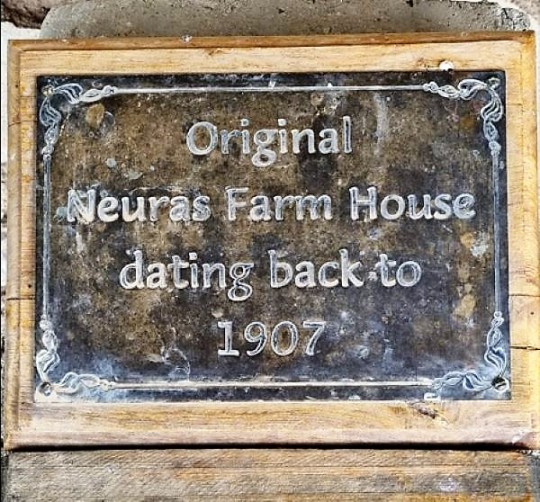
Doch Herman hatte das Potential des Areals erkannt, baute Obst - darunter die ersten Tafeltrauben -, Gemüse und Getreide an und richtete einen Rastplatz für die deutschen Kolonialtruppen ein.
Allerdings wird Namibia aufgrund seines Klimas wohl nie zu den großen Weinbaugebieten Afrikas zählen, doch ändert dies nichts an der Tatsache, dass die Weine, die hierzulande gekeltert werden, mit genauso viel Liebe hergestellt werden, wie irgendwo anders auf der Welt.
Es gibt auch ein paar Chalets, und man sieht, dass alles rustikal aber dennoch geschmackvoll angelegt wurde.

Anschließend setzten wir uns in den Garten und ließen uns von dem Kellner das Wine Tasting mit Käseplatte erklären. Für den Fahrer gab es ein kleines "Water Tasting" von hauseigenem Quellwasser und dazu einen Sosatie mit Kartoffelchips.
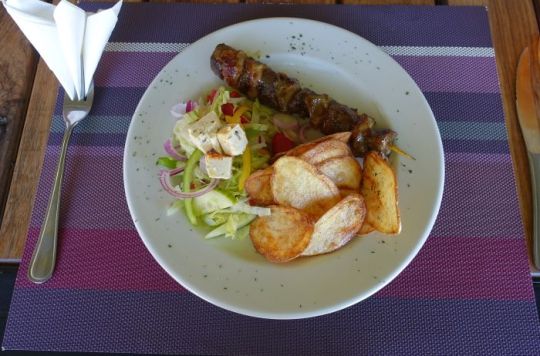
Man kann gemütlich auf der schönen Terrasse sitzen und auch die Angestellten waren sehr aufmerksam. Leider trafen die drei kredenzten Rotweine so gar nicht unseren Geschmack. Für mich wären die Geschmacksnoten irgendwo zwischen Schmunzelbrause und Getriebeöl anzusiedeln.
Gern wären wir noch geblieben, doch es nutzt nix, wir müssen uns loseisen. Unsere nächste Unterkunft, das Desert Camp, wartet auf uns.
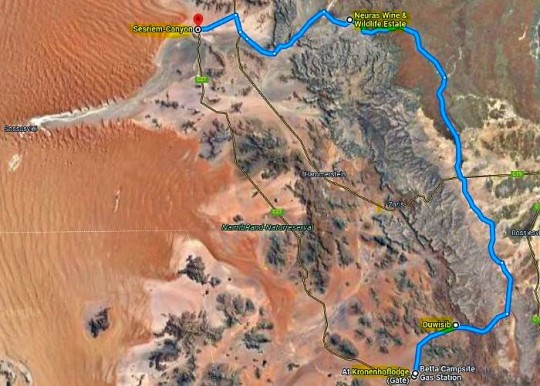
Durch den Namib Rand Nature Reserve Park fuhren wir mit etlichen Foto Stopps weiter bis nach Sesriem. Heute war es eine Strecke von insgesamt 225 Kilometern, die aber, bedingt durch die Stopps und Pausen, dennoch fast 7 Stunden dauerten.

Am Abend warf Micha den Grill vor unserem Chalet an und wir braaiten das bereits per Email vorbestellte Grillpaket, das Schlag 18.15 Uhr ins Haus bzw. die Terrasse geliefert wurde.
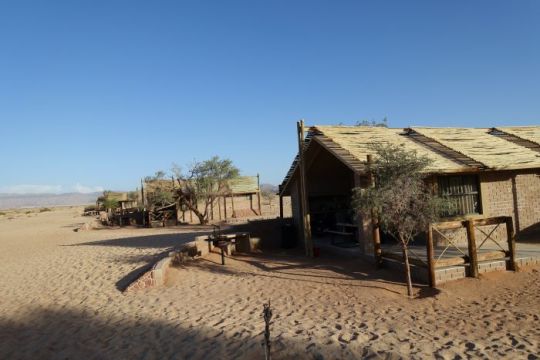
Super Service! Abgerechnet wird bei der Abreise an der Rezeption bei Schlüsselabgabe.
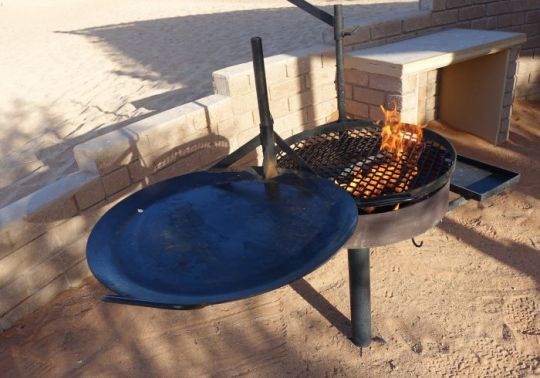
Später am Abend sahen wir irgend etwas in Richtung Wasserloch schleichen.
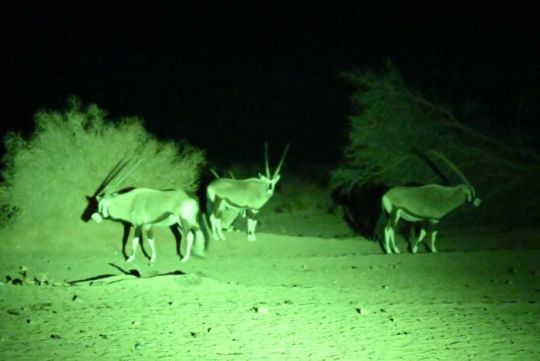
Die grünlichtige (schont die Augen der Tiere) Taschenlampe brachte Aufklärung: eine Herde Oryxantilopen nutze den Schutz der Dunkelheit.
Lekker Slaap!
Angie, Micha, Mama und der Hasenbär
9 notes
·
View notes
Photo

Grand Hotel Kronenhof Inst @fiore_rossella
931 notes
·
View notes
Text
Swiss Bliss - A Luxury Photographer's Dream
Swiss Bliss - A Luxury Photographer's Dream Capturing the Beauty of Swiss Landscapes Switzerland is a country blessed with breathtaking landscapes that inspire photographers to capture their beauty. From the majestic Swiss Alps to the serene lakes and charming towns, this country offers plenty of opportunities to create stunning visuals that tell a story. Here are some ways to capture the beauty of Swiss landscapes: Chase the Light One of the keys to capturing beautiful landscape photography is to chase the light. Whether it's the soft golden hour light in the morning or the warm hues of sunset in the evening, the right light can transform an ordinary scene into a stunning masterpiece. Switzerland offers some of the most spectacular light shows, especially in the mountains where the sun can create dramatic shadows and highlights. Explore the Countryside Switzerland has a lovely countryside that is often overshadowed by the Alps. However, the rolling hills, green meadows, and quaint villages offer a laid-back charm that is perfect for capturing tranquil and idyllic scenes. Take a walk in the quiet countryside and discover hidden gems that are often overlooked by tourists. Shoot from High Altitudes The Swiss Alps are the most iconic landscapes of Switzerland. Shooting from high altitudes not only offers a unique perspective but also showcases the grandeur and power of the mountains. Hike up to magnificent viewpoints, take hot air balloon rides, or ride cable cars to capture stunning aerial views of the Swiss Alps. Experiment with Seasons Switzerland is beautiful all year round, and each season offers a unique charm that can be captured in photographs. In the spring, you can photograph colorful wildflowers in the countryside. In the summer, you can capture the vibrant blue lakes and lush greenery. In the autumn, you can capture the golden foliage and misty mornings. And in the winter, you can capture the snowy landscapes that seem straight out of a fairy tale. In conclusion, capturing the beauty of Swiss landscapes requires some creativity, patience, and a keen eye for detail. Keep exploring, experimenting, and chasing the light, and you'll soon have a portfolio full of stunning Swiss photography that captures the essence of this beautiful country. Experiencing Luxury Accommodations in Switzerland If you're looking for a truly luxurious experience in Switzerland, look no further than its world-renowned hotels. The Swiss are known for their attention to detail, and this is reflected in their hotels, which offer exceptional service and amenities. Grand Hotel Kronenhof, Pontresina Located in the picturesque village of Pontresina in the Engadin valley, the Grand Hotel Kronenhof is a five-star hotel that offers unparalleled luxury. The hotel's 112 rooms and suites are beautifully appointed, with marble bathrooms and stunning views of the mountains. The hotel's spa is a highlight, with an indoor pool, sauna, steam room, and a range of treatments on offer. Gstaad Palace, Gstaad The Gstaad Palace is an iconic hotel that has been welcoming guests since 1913. The hotel's 104 rooms and suites are elegantly furnished and offer stunning views of the Swiss Alps. The hotel's restaurants are exceptional, with a Michelin-starred restaurant and a traditional Swiss restaurant. The hotel also has a spa, indoor and outdoor pools, and a range of activities on offer, including skiing and ice skating. Beau-Rivage Palace, Lausanne The Beau-Rivage Palace is a historic hotel located on the shores of Lake Geneva in Lausanne. The hotel's 168 rooms and suites are decorated with classic elegance and offer views of the lake or the gardens. The hotel's Michelin-starred restaurant, Anne-Sophie Pic, is a highlight, as is the hotel's spa, which offers a range of treatments. Staying at one of these iconic Swiss hotels is sure to be an unforgettable experience. From exceptional service to stunning views, these hotels offer the ultimate in luxury. Exploring the Best Photography Spots in Swiss Cities Geneva Geneva is a city filled with stunning natural scenery, picturesque lakes, and unique architecture. Head to the Jet d'Eau, a water fountain that shoots up to 140 meters high, for a stunning view of Lake Geneva. The Old Town is also a must-visit, with its narrow streets, charming buildings, and the stunning St. Pierre Cathedral. The United Nations Palace, Parc des Eaux-Vives, and Place du Bourg-de-Four are also great photo spots. Zurich Zurich is a city of contrasts, with its old-world charm and modern energy. The Old Town is lined with cobblestone streets, colorful buildings, and beautiful churches. The Fraumünster Church and the Grossmünster Church are must-visit photography spots. The lakefront is also stunning, with views of the Alps in the distance. The lively Bahnhofstrasse and the trendy Zurich West area are also great places to capture the city's vibrant energy. Bern Bern is a UNESCO World Heritage site, known for its well-preserved medieval architecture. The Old Town is a photographer's paradise, with its narrow streets, fountains, and charming buildings. The Zytglogge Tower and the Bern Cathedral are must-visit photography spots. Head to the Rose Garden for stunning views of the city and the Aare River. The Paul Klee Center, located on the outskirts of the city, is also a great photo spot with its modern architecture and beautiful views. Lucerne Lucerne is a picture-perfect Swiss city, with its picturesque lake and stunning mountains. The Chapel Bridge is a must-visit photography spot, with its unique wooden structure and stunning views of the city. The Old Town is also full of charm, with its colorful buildings, cobblestone streets, and the stunning Jesuit Church. The Lion Monument, dedicated to the Swiss Guards who were killed in the French Revolution, is also a popular photo spot. Lausanne Lausanne is a city full of culture, with its museums, galleries, and beautiful architecture. The Olympic Museum is a must-visit photography spot, with its modern architecture and stunning views of Lake Geneva. The Cathedral of Notre-Dame is also a must-visit, with its Gothic architecture and stunning stained-glass windows. The Old Town is full of charm, with its narrow streets and beautiful buildings. Head to the Sauvabelin Tower for stunning views of the city. Indulging in Swiss Cuisine and Wine Switzerland is known for its chocolate and cheese, but the country has much more to offer in terms of culinary delights and wine. Swiss cuisine is a mix of influences from surrounding countries such as Italy, France, and Germany, making it a unique and diverse cuisine. Traditional Swiss Dishes One of the most famous Swiss dishes is fondue, a cheese dish where bread is dipped into a pot of melted cheese. Raclette is another cheesy dish where a half-wheel of cheese is melted and scraped onto potatoes or bread. Rösti, a potato dish, is a popular breakfast item that can be found in any Swiss restaurant. Swiss chocolate is also a must-try, with brands such as Lindt and Toblerone originating in Switzerland. Swiss Wine Switzerland is a primarily a wine-producing country, with vineyards producing wine for centuries. The most popular Swiss wine is Chasselas, a white wine that is light and crisp. Pinot Noir is another popular wine that is grown in the French-speaking region of Switzerland. Visitors can go on wine tours and tastings in the Swiss countryside, visiting the vineyards and learning about the winemaking process in Switzerland. Michelin-Starred Restaurants Switzerland also boasts several Michelin-starred restaurants, where visitors can experience upscale Swiss cuisine with gourmet twists. Restaurant de l'Hôtel de Ville in Lausanne is the most famous, with three Michelin stars and a menu that features luxurious and creative dishes. Other Michelin-starred restaurants include After Seven in Zermatt and Cheval Blanc in Basel. Indulging in Swiss cuisine and wine is a must-do when visiting Switzerland. From traditional dishes to haute cuisine, there is something to satisfy everyone's tastes. And don't forget to pair your meal with a glass of Swiss wine for the ultimate culinary experience. Discovering Switzerland's Rich Culture and History Discovering Switzerland's Rich Culture and History Switzerland is not just a country of beautiful landscapes and luxurious attractions; it also boasts a rich and interesting culture and history. Exploring the country's cultural and historical sites is a must-do activity for any visitor. H2: Museums and Galleries Switzerland is home to some of the most impressive museums and galleries in the world. Art lovers should visit the Kunstmuseum Basel, which houses an extensive collection of European paintings and sculptures from the medieval period to contemporary times. Those interested in history should visit the Swiss National Museum in Zurich, which covers Swiss history from prehistoric times to the present day. H2: Architecture Switzerland has a diverse mix of architectural styles. Gothic architecture can be found in churches and cathedrals such as the Basel Minster and the Cathedral of St. Nicolas in Fribourg. Renaissance and Baroque styles are seen in many palaces and government buildings. The city of Geneva is famous for its modern architecture, including the Jet d'Eau and the International Museum of the Red Cross. H2: Festivals and Traditions Switzerland is known for its festivals and traditions, with many events happening throughout the year. One of Switzerland's most famous traditions is the Chalandamarz festival, which takes place in early March. The festival celebrates the end of winter and the beginning of spring, with parades and traditional costumes. Another popular festival is the Fasnacht carnival in Basel, which takes place during the week leading up to Ash Wednesday. H2: Food and Drink Switzerland is renowned for its delicious cuisine and world-famous chocolate. Swiss cheese, including Emmental and Gruyère, are popular worldwide. Swiss chocolate is also a must-try for any visitor. Switzerland is also known for its wine, with several wine regions producing high-quality wines, including Chasselas and Pinot Noir. H3: Conclusion Switzerland's rich culture and history make it a fascinating country to explore. From the world-class museums and galleries to the impressive architectural styles and traditional festivals, there is something for everyone. Be sure to sample some of the country's delicious food and drink while exploring all that Switzerland has to offer – and don't forget to bring your camera to capture all of the stunning sights and experiences. Engaging in Adventure Activities in Swiss Alps If you’re looking for adrenaline-pumping adventure activities in Switzerland, look no further than the Swiss Alps. With its majestic snow-capped peaks, jaw-dropping scenery, and a plethora of activities to choose from, the Swiss Alps attract adventure seekers from across the globe. Skiing and Snowboarding The Swiss Alps are a mecca for skiing and snowboarding enthusiasts. With over 200 ski resorts, numerous runs, and an extensive network of lifts, skiers and snowboarders of all levels can enjoy the thrill of sliding down the slopes. Paragliding Experience the thrill of flying like a bird with paragliding. Soar over the breathtaking landscapes of the Swiss Alps, including glaciers, forests, and mountain villages. You don’t need experience to take part in this adventure, just a sense of adventure and a desire to fly. Ice Climbing Ice climbing is an excellent way to challenge your physical and mental abilities. With numerous icefalls, frozen waterfalls, and ice walls to climb, the Swiss Alps provide the perfect setting for this adventure activity. Whether you’re a beginner or advanced climber, there’s a route for everyone. Snowshoeing Take a peaceful stroll in the snow and explore the beautiful winter wonderland of the Swiss Alps. Snowshoeing is a popular activity for those who want to immerse themselves in nature, away from the hustle and bustle of the ski slopes. Cross-Country Skiing Experience the freedom of gliding through the snow-covered valleys and forests of the Swiss Alps on cross-country skis. This activity is perfect for those who want to enjoy the beautiful scenery at a more leisurely pace. Sledging If you’re looking for a fun-filled activity, then sledging is for you. Sledge down the mountain slopes at high speed, laughing and screaming with glee. With numerous toboggan runs, sledging is a popular activity for families, friends, and groups. Switzerland’s alpine region is an adventurer's paradise. The Swiss Alps offer a vast range of activities, from heart-stopping adrenaline rushes to peaceful winter walks. The beauty of Swiss Alps is that every season offers its unique charm and range of activities. Whether you are a beginner or an experienced adventurer, the Swiss Alps have everything that you need for an unforgettable holiday. Tips for Planning Your Dream Swiss Getaway Planning a trip to Switzerland can be overwhelming, but with a little research and preparation, it can be the vacation of a lifetime. Here are some tips to help you plan your dream Swiss getaway: 1. Determine Your Budget Switzerland can be an expensive country to visit, so determine your budget before you start planning your trip. Consider the cost of flights, accommodations, transportation, food, and activities. 2. Choose Your Time of Year The best time to visit Switzerland depends on what you want to do. Summer offers hiking and outdoor activities, while winter is perfect for skiing and snowboarding. Spring and fall can be less crowded and offer more affordable prices. 3. Book Accommodations Early Switzerland has many luxury and boutique hotels, but they can book up quickly, especially during peak season. Book your accommodations early to ensure you get the room and location you want. 4. Plan Your Activities Switzerland offers a variety of activities, including skiing, hiking, visiting museums, and exploring charming villages. Research the activities you want to do and make reservations in advance to avoid disappointment. 5. Try Swiss Cuisine Switzerland is known for its delicious cheese and chocolate, as well as its traditional dishes like raclette and fondue. Be sure to try some of the local cuisine to truly experience Swiss culture. 6. Pack Properly Switzerland has a variety of weather conditions, so be sure to pack for all seasons. Bring layers, comfortable shoes, and any necessary outdoor gear for the activities you plan to do. By following these tips, you can plan your dream Swiss getaway and make unforgettable memories. If you're looking for some luxurious, off-the-beaten-path destinations to photograph, check out Spain's hidden gems - Photographing the lesser-known luxury destinations. Read the full article
0 notes
Text
Hotel Kronenhof em Zurich foi palco para a consagração de Claudio Penido como palestrante da maior festa popular, o Carnaval
Hotel Kronenhof em Zurich foi palco para a consagração de Claudio Penido como palestrante da maior festa popular, o Carnaval Adele Fátima e Elly Poloni também participaram do evento que pontuou a “Feira da Dona da Banca”. A data de 23 de outubro foi pra lá de especial para Claudio Penido. Realizado no Hotel Kronenhof, em Zurich, Suíça, o evento “Ferinha da Dona da Banca” reuniu mulheres…

View On WordPress
0 notes
Photo

Asanas inmitten der Engadiner Bergkulisse Das Grand Hotel Kronenhof in Pontresina in der Schweiz begeistert mit vier neuen Yoga-Plattformen im Freien. Diese sind die perfekte Ergänzung des Fitness- und Sportangebotes im Spa.
0 notes
Text
Namibia 2023/24 - Tag 16
Herrschaften und Oukies!!!
Wir verließen Lüderitz und die Pension "Zur Waterkant" heute wieder. Es stürmte immer noch, allerdings nicht mehr ganz so stark, wie bei unserer Anreise.

Micha verarztete unseren Hilux dahingehend, indem er die Scheinwerfer mit Klarsichtfolie abklebte, damit sie nicht abgeschmirgelt und blind werden. Marion Schelkle erzählte uns gestern, dass sie pro Jahr 3 Windschutzscheiben benötigt. Respekt!
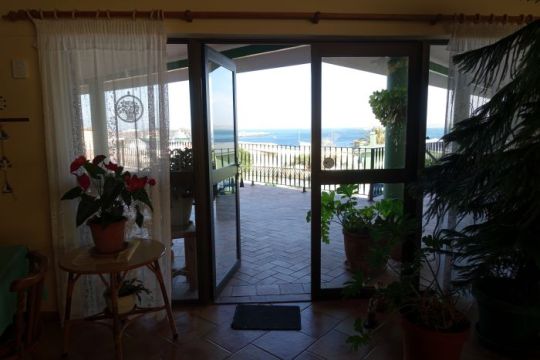
So machten wir uns nach dem Frühstück auf und fuhren erst einmal die 125 Kilometer auf der prima Teerstraße zurück bis nach Aus. Es gibt keinen anderen Weg, da sich links und rechts das Diamantensperrgebiet erstreckt.

Das Diamantensperrgebiet liegt mitten in der Namibwüste, aber es hätte auch genauso gut im Vorhof der Hölle liegen können.

Die Namib ist eine der lebensfeindlichsten Wüsten der Erde, meist gibt es nur Sand und Felsen und dazu einen unbändigen Wind, der beinahe täglich in Küstennähe über das Land stürmt.

Wir halten kurz an der ehemaligen Bahnstation "Grasplatz" der Aus-Lüderitz Linie, ganz in der Nähe der heutigen B 4. Die heißt jetzt nicht etwa so, weil es zwischen all dem Sand und der Steine, plötzlich GRAS gibt.

Der Ort hieß ursprünglich Grasabladeplatz, da hier das Futterheu für die Ochsen gelagert wurde, die die langen Ochsenwagen, von Lüderitz ausgehend, durch die wasserlose Ödnis zogen.
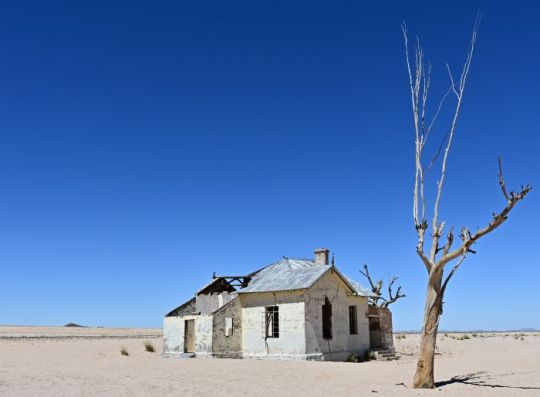
Der nächste Haltepunkt ist die alte Bahnstation von Garub, was in der Sprache der Nama „Leopard“ bedeutet.

Garub liegt heute an der viel befahrenen Touristenroute zwischen Aus und Lüderitz im Süden des Landes. Das war natürlich nicht immer so.
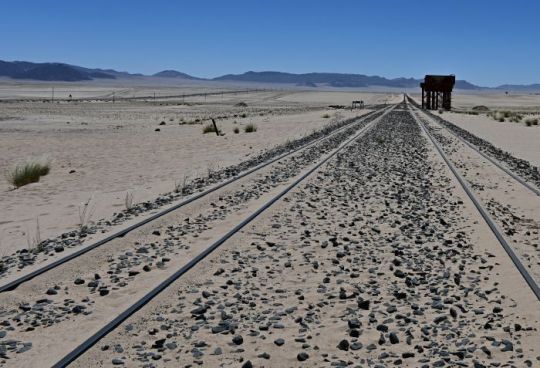
Garub begann in der Geschichte erst eine Rolle zu spielen, als 1906 die Eisenbahnlinie von Lüderitz ins Landesinnere gebaut wurde. Bei Garub wurde 1908 unterirdisches Wasser entdeckt – ein kostbares Gut in den extremen Verhältnissen der Wüste.
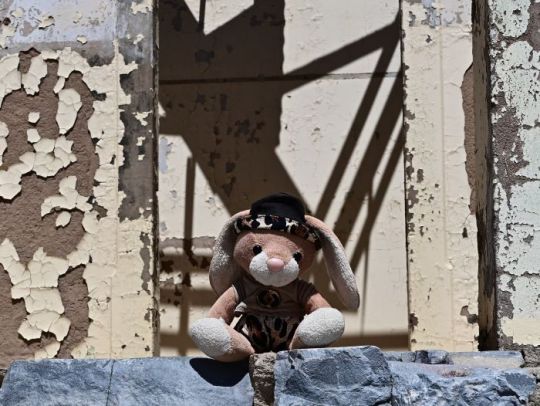
Viele Jahre später wurde die Umgebung von Garub als Heimat der namibischen wilden Pferde bekannt.
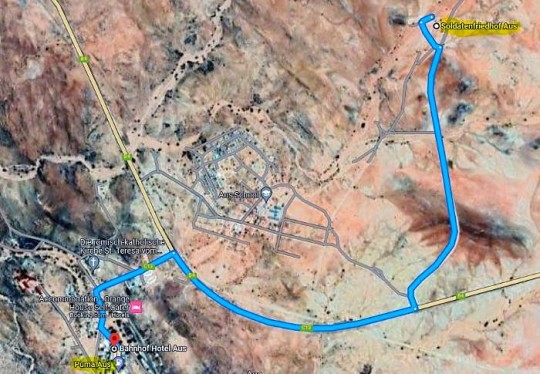
Nach weiteren 110 Kilometern erreichen wir wieder den Ort Aus. Hier besichtigen wir heute den Soldatenfriedhof, der etwas nördlich des Ortes liegt.
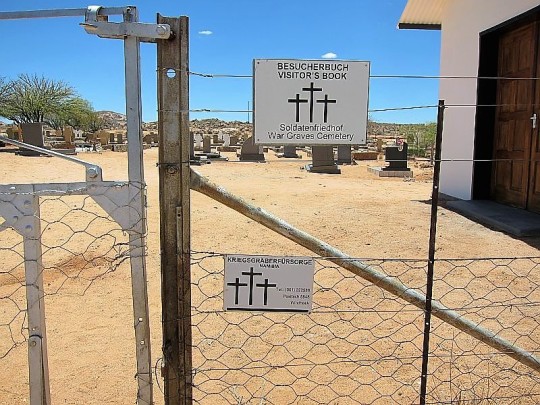
Hier liegen Gräber von Soldaten verschiedener Nationen neben und hinter einander, etwas weiter vorne findet man Gräbern aus der heutigen Zeit.

Nach der Kapitulation der Deutschen, am 9. Juli 1915, etablierte die südafrikanische Armee ein Internierungslager für mehr als 1500 deutsche Soldaten östlich von Aus.

Das Lager wurde 1918 von der spanischen Grippe heimgesucht.

Sowohl Gefangene als auch Bewacher erkrankten gleichermaßen – viele starben.
An zahlreichen Grabsteinen lässt sich ablesen, dass die Spanische Grippe etliche Opfer forderte.

Gegen Mittag Uhr fuhren wir ganz kurz über die B 4, um dann auf die Piste C 13, in Richtung Norden einzubiegen.
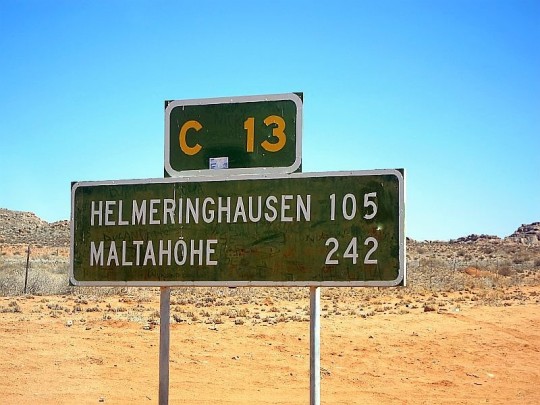
Wie wir noch von den letzten Malen in Erinnerung hatten, war die Strecke auch heute in sehr schlechtem Zustand.
Schon weit vorher konnten wir die Tiras-Berge und, linker Hand, die unglaublich rot leuchtenden Dünen erkennen.
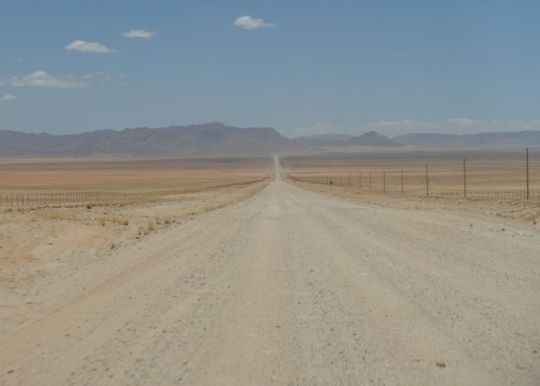
Das Gebiet der Tirasberge umfasst ca. 125.000 Hektar und befindet sich innerhalb des Dreiecks zwischen dem Fish River Canyon, dem Sossusvlei und der Lüderitzbucht.

Die meisten Besucher sehen die Landschaft von der D 707 aus, die vielen als schönste Strecke in Namibia gilt. Dafür fehlt uns leider bei dieser Reise die Zeit.
Am späten Mittag kehrten wir im berühmten Hotel von Helmeringhausen ein. Nicht etwa das Helmeringhausen im Sauerland, sondern das in Namibia.

Die Namensgleichheit mit dem Ort im Sauerland kam natürlich nicht zufällig zustande. Hubert Hester, Vorfahre des bekannten Autoverleihers aus Windhoek, wurde nämlich im sauerländischen Helmeringhausen geboren. Er war Mitglied der kaiserlichen Schutztruppen und ließ sich an eben diesem Ort, im damaligen Deutsch-Südwest, nieder.
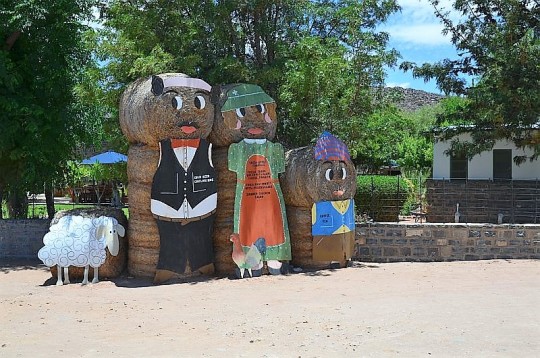
Das kleine Nest ist in seiner einsamen Verlorenheit eine echte Versorgungsoase. Hotel, kleiner Landhandel und eine Tankstelle - also, Tankstelle im wahrsten Sinne des Wortes: eine Stelle zum tanken!

Im gleichnamigen Hotel mit großem Garten gibt es angeblich den besten Apfelkuchen Namibias - ich würde sogar sagen: südlich der Alpen!
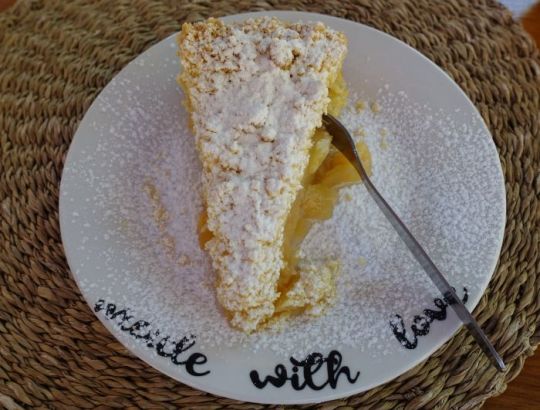
Bis vor einigen Jahren galt diese Ortschaft noch als ein Zentrum der Karakulzucht, jedoch ging auch hier der Niedergang nicht spurlos vorbei.
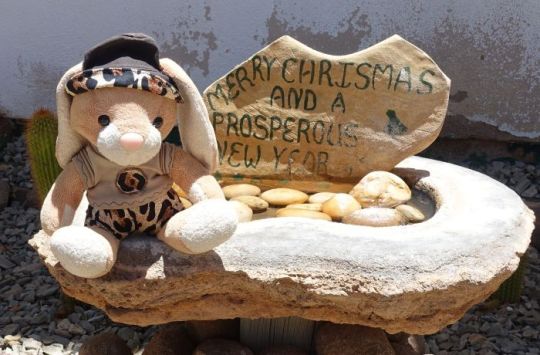
Vor einigen Jahren gründete die örtliche Farmergemeinschaft ein landwirtschaftliches Mini-Museum, direkt neben dem Helmeringhausen Hotel und dem Campingplatz. Hier wurden interessante Nutzgeräte aus längst vergangener Zeit zusammengetragen und ausgestellt.

Heutzutage ist Helmeringhausen vor allem durch sein Hotel, das von dem Ehepaar Björn und Katja Basler geführt wird, bekannt. Das Hotel ist eine grüne Oase in der sonst so staubigen Umgebung.

Die recht übersichtliche Speisekarte bietet neben dem ausgezeichneten Apfelkuchen, noch selbst gebackenes Farmbrot, Leberkäse und Bratwurst.

Alles ganz frisch, selbst gemacht und sehr lecker.
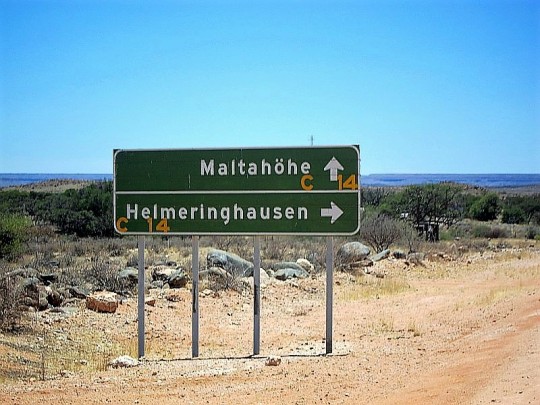
Nach weiteren 90 Minuten, über die C 27, erreichen wir das Eingangstor zum Gelände der recht neuen At Kronenhof Lodge.

Vom Tor sind es dann noch einmal 10 Kilometer über sandige Farmpisten bis zum Hauptgebäude der Lodge.

Wir beziehen unser klimatisiertes Familienzimmer mit 2 Schlafzimmern, einem riesen Badezimmer, Carport und einer schönen Aussicht über das Gelände.
Lekker Slaap!
Angie, Micha, Mama und der Hasenbär
#lüderitz#Grasplatz#Aus#Tiras Berge#Tiras Mountains#Helmeringhausen#At Kronenhof Lodge#namibia#afrika#africa
8 notes
·
View notes


